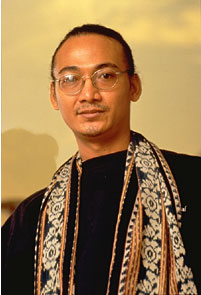|
|
|
||||||
|
|
|||||||
|
The various machines created by Heri Dono present appearances and movements far removed from the Western concept of the machine. |
 |
|
|
Heri Dono converts what he has gained from the study of traditional Indonesian performance arts such as Gamelan music, dance and Wayang Kulit (shadow pictures) into new forms in his automatic works of art. He has also produced machines and installations based on the phenomena and ritual practices seen in the primitive religions of Java and Bali. These works consistently display a form of animism and reflections on vitality. Heri Dono brings life to all that he touches. Or rather, we should say that everything in the world has a soul, and even electrical currents possess life. That life passes through machines and technology to appear before us in reality. For Heri Dono, this kind of animistic view is surely an important factor toward establishing links between East and West, high tech and low tech, the self and the world.
Cutting edge technology has already built up the fastest, highest and most advanced systems of communication and information, and these systems are now diversifying. However, people on the periphery have almost no awareness of this, so such systems have no meaning for them. Truth and falsehood are both reduced to the level of rumors and relative meaning. Electric currents, sounds, steel plates, electronic circuitry, the atmosphere of the internal and external worlds and the like all form the constellation that binds human existence to the world of the supernatural.
(Heri Dono, "Throughout the Era of Marginalization," in The Fourth Asian Art Exhibition catalogue, Fukuoka Museum of Art, 1994)
Heri Dono was born in Jakarta, Indonesia in 1960. He studied at the Indonesian Institute of the Arts in Yogyakarta from 1980 to 1987, after which he received intensive training in the traditional Indonesian arts of Wayang Kulit, Gamelan, and dance. It was in the 1990s that he began to create automatic machine art. He has participated in exhibitions in the Netherlands, Germany, Australia and has held exhibitions and workshops in Japan. He is also very active as a performance artist. Aspiring to create an original Asian machine art, Heri Dono is an artist to keep our eyes on in the future.
(ITOH Toshiharu, art critic)
|
||